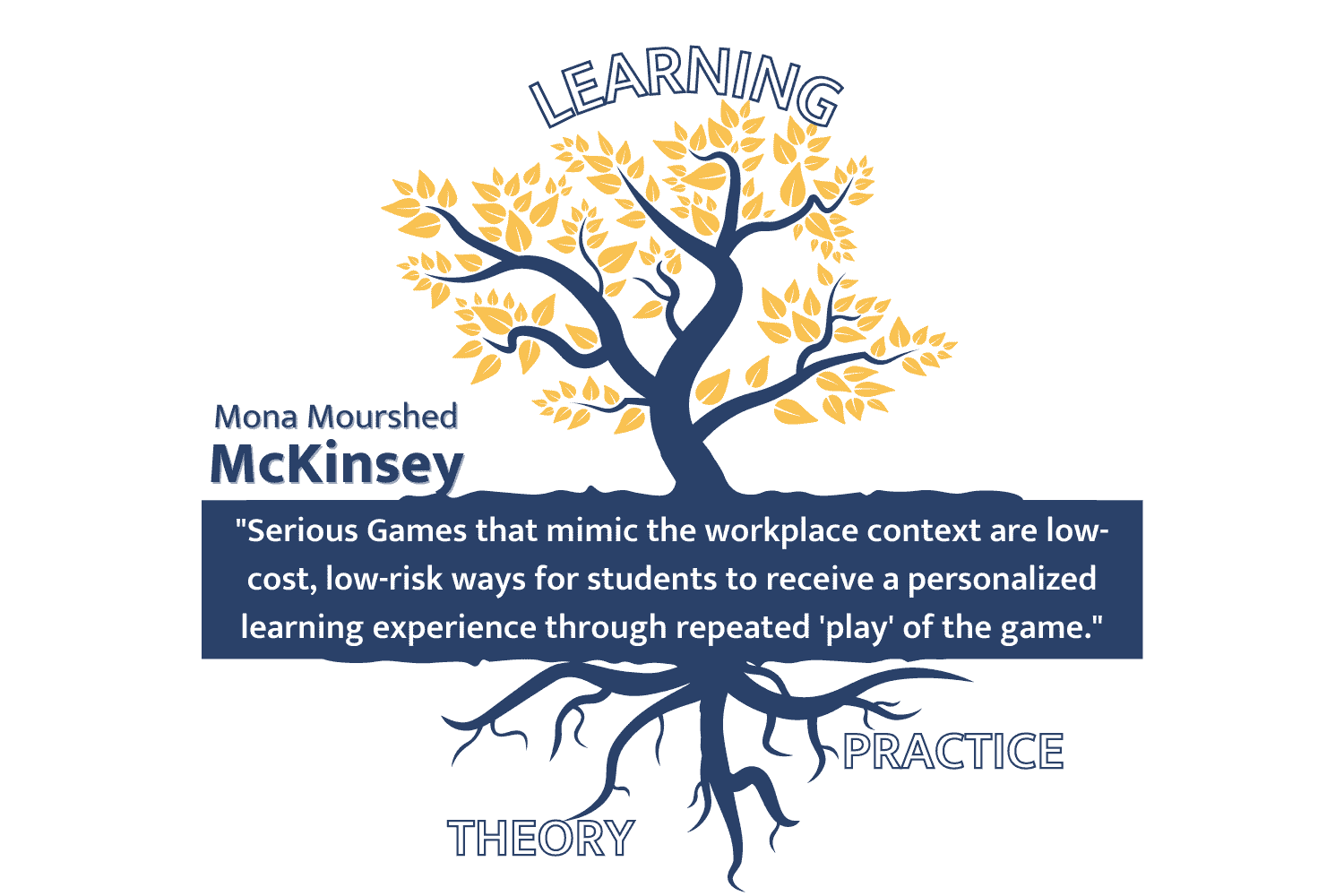The Value of Business Simulations in Introductory Business Courses
Written by: Torsor Kotee
The explosion of generative AI is driving a fundamental shift in education. As AI-generated content becomes more prevalent, students can and will easily access solutions to traditional assignments. Our efforts and energy should focus not on blocking these tools, as that is a losing battle, but on changing how we teach students and assess their learning. In fact, we should embrace these tools and evolve from being the primary source of information to facilitators of learning. This shift requires us to prioritize guiding students in developing critical thinking and problem-solving skills. These competencies, along with teamwork skills, are highly valued by employers and are considered essential skills for college graduates (National Association of Colleges and Employers (NACE). With employers increasingly engaging undergraduates as early as their freshman year, introductory business courses play a crucial role in cultivating these highly sought-after skills right from day one.
Given the rise of generative AI and the need to develop essential skills, how can faculty, especially those teaching large introductory business courses, best prepare their students for success? In this article, we’re going to make the case for business simulations, and why they offer the greatest value for instructors who teach these courses.
Content Index
Business Simulations | What are they and why are they relevant
System Thinking
In an introductory business course, students are typically introduced to the core business disciplines in sequence and silos. For instance, an instructor might dedicate a week or two to exploring marketing, followed by segments on operations, finance, and other areas. To provide students with a more integrated understanding, instructors might include individual and/or group projects in their curriculum. This is where the value of a business simulation becomes most apparent.
Imagine if first-year students could experience what business leaders face, having to navigate ambiguity and uncertainty when making decisions. Imagine if they were solving complex problems with no right answers, like in the real world—problems that ChatGPT can’t solve…yet.
Enter the business simulation—an interactive educational tool that mirrors real-world business scenarios. Here, students are grouped into teams, competing against each other in a simulated business environment where they make cross-functional decisions with uncertain outcomes. This approach allows students to act as if they were managing a real business, quickly gaining firsthand experience of the complexity of each core business discipline and how these disciplines must work together to achieve goals (systems thinking).
The Case for Business Simulations vs. Other Assignments
According to Edgar Dale’s Cone of Experience, learners remember 10% of what they read, 50% of what they see and hear, 70% of what they say and write, and 90% of what they do. Taking a learning by doing approach, business simulations are suggested by many publications and businesses, including McKinsey, as a key step forward in providing the skills that students lack. Knowledge becomes sticky as students practice making impactful decisions using what they learn in an engaging simulated setting and find insights from the consequences.
What makes business simulations stand out from other group projects such as textbook assignments, case studies, company analyses, and real client projects?
The short answer is that business simulations are very aligned with Intro to Business course objectives, they provide frequent feedback for students, and they can be easily deployed, managed, and graded in a matter of minutes. Additionally, unlike other methods, students cannot rely on ChatGPT for solutions.
Business simulations are the best tool to help young learners gain a basic understanding of how business works because they provide experiential learning, active engagement, and real-time feedback. They offer a risk-free environment for students to experiment and promote teamwork. Unlike other assignments, simulations swiftly navigate students through core business disciplines, offering a holistic understanding in moments that would otherwise require weeks or months. This accelerated learning journey not only educates but also empowers students to apply theoretical knowledge to practical scenarios, fostering a deeper and more practical grasp of business concepts. It is second only to having students work on a real client project.
Now, let's compare simulations to alternative projects that help students nurture essential skills, starting with real client projects.
Simulation vs. Real Client Project
Nothing compares to working on a real client project. Students are motivated, engaged, and gain practical experience as they see the direct impact of their work and contributions. This hands-on experience also allows students to build a portfolio of work that demonstrates their skills and capabilities to potential employers or clients. It’s why numerous programs include real client projects in their first-year undergrad business courses.
Managing a real client project, however, presents several challenges. These challenges range from finding a client willing to create a project suitable for first-year students, to learning objectives alignment and coordination, to ensuring that students are adequately prepared with basic business fundamentals for the project.
In this regard, a simulation serves as an ideal assignment to prepare first-year students for real client projects. It provides a controlled environment where students can quickly learn and experiment without the risk of real-world consequences. Students can make cross-functional decisions, test strategies, and experience the outcomes in a safe and supportive setting. This allows them to develop foundational knowledge of how business works and gain confidence before applying their knowledge and skills to a real client project. For instance, when students need to consider product and marketing strategies in their real client project, they will be more likely to take into account other aspects of the business, such as operational and financial resource constraints. (Miami University uses a business simulation to prepare their 800 first-year students for their real client project).
Additionally, simulations can be easily scaled to accommodate a large number of students and can be tailored to specific learning objectives.
Simulation vs. Case Studies
A business case study is another powerful tool, traditionally used in graduate-level business programs. Unlike a typical lecture where students passively receive information, the case method requires active participation. Students become detectives, analyzing a real company challenge or opportunity, and the instructor becomes a facilitator, guiding students through the learning process.
One of the key benefits of case studies is the lively class discussions they inspire, where students share and debate their varied viewpoints, often drawing on their professional experiences. For first-year students with little to no professional experience, this can pose a challenge for instructors.
Sports analysts discussing Sunday’s football game
However, what primarily sets simulations apart from case studies is their real-time nature. Students are not merely analyzing past events like the Monday morning quarterbacks; instead, they are actively engaged as protagonists, experiencing the complexities and uncertainties of their decisions firsthand. In addition, they are getting continuous feedback, which helps students with little to no experience quickly gain a better understanding of how business works.
Simulation vs. Company Research & Analysis
Having students research a company of their choosing and conduct analysis also offers several benefits including the opportunity to apply theoretical concepts learned in class to a real company. It fosters critical thinking and often involves collaborative teamwork. However, in the era of GenAI, students can effortlessly complete such assignments, potentially missing out on the investigative and problem-solving processes.
In a business simulation, students can utilize ChatGPT to comprehend concepts introduced in the simulation. For instance, if they wish to delve deeper into the distinctions between forms of capital (debt vs. equity), they can employ ChatGPT to conduct research and explore these concepts. This process encourages them to think more critically about the questions they need to pose.
However, even with their utmost efforts, the success of any capital raised remains uncertain. The moves of competitors are unpredictable. Moreover, simulations require consideration of numerous variables and trade-offs that span across all core business disciplines, including product, marketing, operations, and finance. Each decision made in one area can impact other aspects of the business, making it difficult for ChatGPT to determine the best course of action without a deep understanding of these interconnected disciplines. While a student with domain expertise might be able to develop such prompts with time and effort, the average first-year student will likely not.
Choosing The Right Business Simulation
There are several business simulations on the market and many align well with introductory business course curricula, offering an integrated learning experience across all core business disciplines. The key distinguishing factors among these simulations include their guidance and feedback mechanisms, ease of management, and responsiveness to support.
Traditionally, simulations have been tailored for upper-level undergraduate courses, MBA programs, and corporate training. Therefore, when considering a simulation for a first-year course, it's crucial to ensure that it offers robust guidance and feedback mechanisms. First-year students often require more support than their counterparts in higher levels of education. Guidance helps students navigate the simulation, while immediate and ongoing feedback keeps them engaged, clarifies complex concepts, and encourages critical thinking by explaining the rationale behind decisions and outcomes.
Opting for a simulation lacking in these areas can result in a flood of student inquiries, emails, and headaches.
This underscores the importance of ease of management. The technology should enhance the instructor's impact on the course while reducing their workload. This is where guidance and feedback features, as well as integrated peer evaluation, play a critical role.
Peer evaluation is crucial as it promotes collaborative learning, enhances communication skills, and provides students with a broader perspective on their performance. An effective simulation should seamlessly incorporate peer evaluation without requiring instructors to use separate tools or platforms. This not only streamlines the grading process but also enriches the learning experience by encouraging students to actively participate in each other's learning process. Additionally, a well-designed peer evaluation system can reduce the burden on instructors by involving students in the assessment process, ultimately fostering a more engaging and interactive learning environment.
Lastly, the simulation should provide responsive support, ensuring that instructors receive timely responses to inquiries, ideally within a few hours (if not within an hour). This ensures a smooth learning experience for both students and instructors, avoiding unnecessary delays or frustrations.
To learn more about Market Games’ business simulation for introductory business courses, check out our case study.







